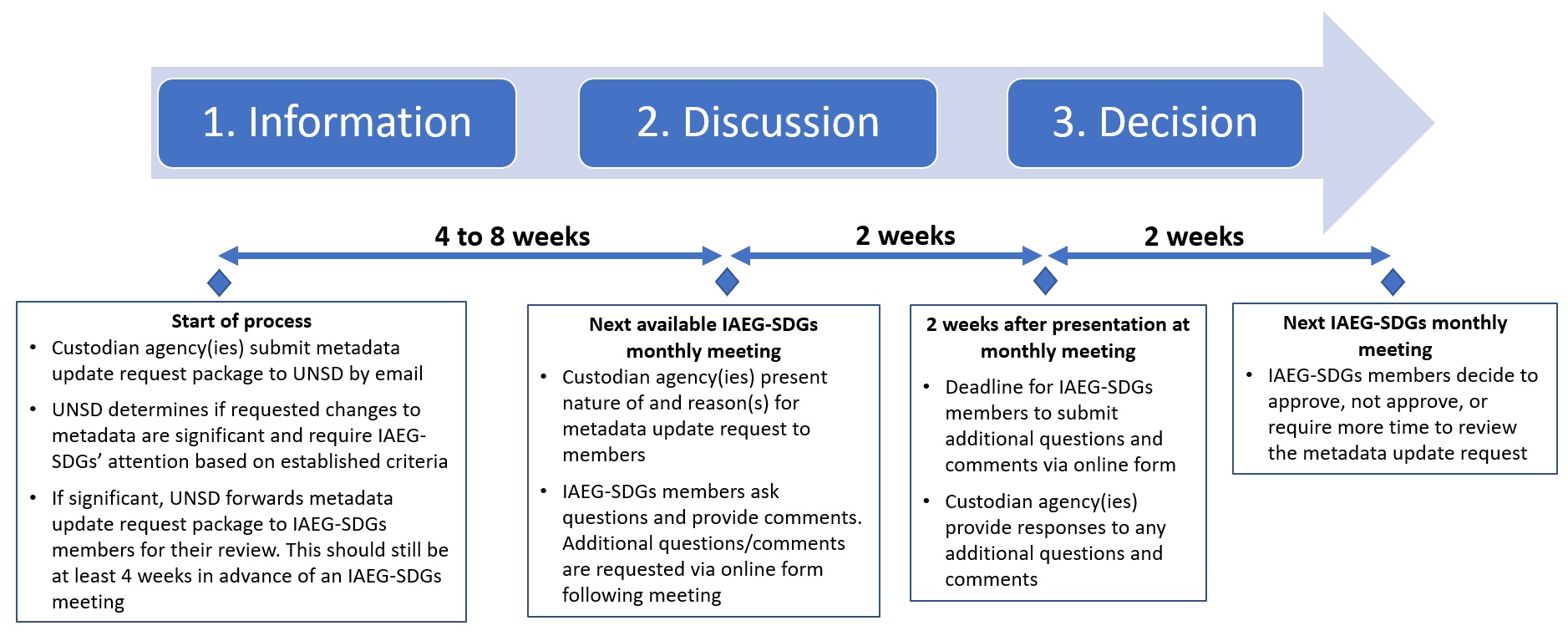SDG Indicators
Metadata repository
The metadata available in this repository is a work in progress. It reflects the latest reference metadata information provided by the UN System and other international organizations on data and statistics for the Tier I and II indicators in the global indicator framework. This repository will be further updated and periodically reviewed in cooperation with the respective data compilers.
In addition:
- Official list of Global Sustainable Development Goal indicators
- Tier Classification for Global SDG Indicators
- Previous Work Plans for Tier III Indicators (archive)
- Metadata for initially proposed indicators (archive)
Metadata update process:
Methodology for indicators is expected to update from time to time. For any metadata updates that include significant changes (detailed in the form below), the IAEG-SDGs will review the changes during its member meetings based on the update request form (see below) and track change metadata provided. Custodian agencies will also be invited to attend an upcoming IAEG-SDG member meeting to present on the proposed changes and answer any questions.
As requested by the IAEG-SDGs, custodian agencies must provide their metadata update request documents at least one month in advance of their next scheduled meeting to allow for sufficient time for review. Depending on the time of submission and the next IAEG-SDG member meeting, the timeline for review and approval can span up to 12 weeks or more. Therefore, it is important to provide submissions as soon as they are available. Please note that no data are published in the Global SDG Indicators Database until the corresponding metadata is approved by the IAEG-SDGs.
Please see below the projected stages and timeline.
To get started, custodian agencies are requested to:
- Download the metadata Word file for the indicator from the metadata repository (below) and edit the Word file in track changes to show the requested changes.
- Custodian agency downloads and completes the “Metadata update request form” (below) and sends the request package to sdgindicators@un.org.
Search
Goal 3. Ensure healthy lives and promote well-being for all at all ages
Target 3.1: By 2030, reduce the global maternal mortality ratio to less than 70 per 100,000 live births
- Indicator 3.1.1: Maternal mortality ratio
- Indicator 3.1.2: Proportion of births attended by skilled health personnel
Target 3.2: By 2030, end preventable deaths of newborns and children under 5 years of age, with all countries aiming to reduce neonatal mortality to at least as low as 12 per 1,000 live births and under‑5 mortality to at least as low as 25 per 1,000 live births
- Indicator 3.2.1: Under-5 mortality rate
- Indicator 3.2.2: Neonatal mortality rate
Target 3.3: By 2030, end the epidemics of AIDS, tuberculosis, malaria and neglected tropical diseases and combat hepatitis, water-borne diseases and other communicable diseases
- Indicator 3.3.1: Number of new HIV infections per 1,000 uninfected population, by sex, age and key populations
- Indicator 3.3.2: Tuberculosis incidence per 100,000 population
- Indicator 3.3.3: Malaria incidence per 1,000 population
- Indicator 3.3.4: Hepatitis B incidence per 100,000 population
- Indicator 3.3.5: Number of people requiring interventions against neglected tropical diseases
Target 3.4: By 2030, reduce by one third premature mortality from non-communicable diseases through prevention and treatment and promote mental health and well-being
- Indicator 3.4.1: Mortality rate attributed to cardiovascular disease, cancer, diabetes or chronic respiratory disease
- Indicator 3.4.2: Suicide mortality rate
Target 3.5: Strengthen the prevention and treatment of substance abuse, including narcotic drug abuse and harmful use of alcohol
- Indicator 3.5.1: Coverage of treatment interventions (pharmacological, psychosocial and rehabilitation and aftercare services) for substance use disorders
- Indicator 3.5.2: Alcohol per capita consumption (aged 15 years and older) within a calendar year in litres of pure alcohol
Target 3.6: By 2020, halve the number of global deaths and injuries from road traffic accidents
Target 3.7: By 2030, ensure universal access to sexual and reproductive health-care services, including for family planning, information and education, and the integration of reproductive health into national strategies and programmes
- Indicator 3.7.1: Proportion of women of reproductive age (aged 15–49 years) who have their need for family planning satisfied with modern methods
- Indicator 3.7.2: Adolescent birth rate (aged 10–14 years; aged 15–19 years) per 1,000 women in that age group
Target 3.8: Achieve universal health coverage, including financial risk protection, access to quality essential health-care services and access to safe, effective, quality and affordable essential medicines and vaccines for all
- Indicator 3.8.1: Coverage of essential health services
- Indicator 3.8.2: Proportion of population with large household expenditures on health as a share of total household expenditure or income
Target 3.9: By 2030, substantially reduce the number of deaths and illnesses from hazardous chemicals and air, water and soil pollution and contamination
- Indicator 3.9.1: Mortality rate attributed to household and ambient air pollution
- Indicator 3.9.2: Mortality rate attributed to unsafe water, unsafe sanitation and lack of hygiene (exposure to unsafe Water, Sanitation and Hygiene for All (WASH) services)
- Indicator 3.9.3: Mortality rate attributed to unintentional poisoning
Target 3.a: Strengthen the implementation of the World Health Organization Framework Convention on Tobacco Control in all countries, as appropriate
- Indicator 3.a.1: Age-standardized prevalence of current tobacco use among persons aged 15 years and older
Target 3.b: Support the research and development of vaccines and medicines for the communicable and non‑communicable diseases that primarily affect developing countries, provide access to affordable essential medicines and vaccines, in accordance with the Doha Declaration on the TRIPS Agreement and Public Health, which affirms the right of developing countries to use to the full the provisions in the Agreement on Trade-Related Aspects of Intellectual Property Rights regarding flexibilities to protect public health, and, in particular, provide access to medicines for all
- Indicator 3.b.1: Proportion of the target population covered by all vaccines included in their national programme
- Indicator 3.b.2: Total net official development assistance to medical research and basic health sectors
- Indicator 3.b.3: Health product access index
